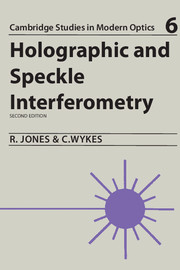Book contents
- Frontmatter
- Contents
- Preface to the first edition
- Preface to the second edition
- Acknowledgements
- 1 Basic optical principles
- 2 Holographic interferometry
- 3 Speckle pattern interferometry
- 4 Electronic Speckle Pattern Correlation Interferometry
- 5 Holographic and speckle pattern interferometry techniques for shape measurements
- 6 Experimental design and technique
- 7 Applications
- Appendices
- References
- Index
4 - Electronic Speckle Pattern Correlation Interferometry
Published online by Cambridge University Press: 05 August 2012
- Frontmatter
- Contents
- Preface to the first edition
- Preface to the second edition
- Acknowledgements
- 1 Basic optical principles
- 2 Holographic interferometry
- 3 Speckle pattern interferometry
- 4 Electronic Speckle Pattern Correlation Interferometry
- 5 Holographic and speckle pattern interferometry techniques for shape measurements
- 6 Experimental design and technique
- 7 Applications
- Appendices
- References
- Index
Summary
Introduction
In the last chapter it has been shown how photographic processing may be used to form speckle pattern correlation fringes (Section 3.3). The resolution of the recording medium used for this technique need be only relatively low compared with that required for holography since it is only necessary that the speckle pattern be resolved, and not the very fine fringes formed by the interference of object and holographic reference beams. The minimum speckle size is typically in the range 5 to 100 μm (Section 3.1) so that a standard television camera may be used to record the pattern. Thus video processing may be used to generate correlation fringes equivalent to those obtained photographically. This method is known as Electronic Speckle Pattern Interferometry or ESPI and was first demonstrated by Butters and Leendertz (1). Similar work has since been described by Biedermann et al. (2) and Løkberg et al. (3,4). The major feature of ESPI is that it enables real-time correlation fringes to be displayed directly upon a television monitor without recourse to any form of photographic processing, plate relocation etc. This comparative ease of operation allows the technique or speckle pattern correlation interferometry to be extended to considerably more complex problems of shape measurement (Chapter 5) and deformation analysis (Chapter 7).
Intensity correlation in ESPI is observed by a process of video signal subtraction or addition. In the subtraction process, the television camera video signal corresponding to the interferometer image-plane speckle pattern of the undisplaced object is stored electronically.
- Type
- Chapter
- Information
- Holographic and Speckle Interferometry , pp. 165 - 196Publisher: Cambridge University PressPrint publication year: 1989
- 9
- Cited by



